Management Accounting Assignment Solution - Cost and Profit Analysis
VerifiedAdded on 2020/03/15
|16
|2155
|47
Homework Assignment
AI Summary
This document provides a comprehensive solution to a management accounting assignment. It begins with a physical flow and equivalent units analysis for the assembly department, including unit cost calculations and cost reconciliation. The solution then delves into corporate sustainability, examining financial, social, and environmental considerations for setting up a new factory. Furthermore, it includes analysis of shipping department costs using high-low and least squares regression methods, along with cost-volume-profit analysis, exploring break-even points, margin of safety, and operating leverage. Finally, the assignment covers inventory costing under both absorption and variable costing systems, along with a comparison of product costing using traditional and activity-based costing methods and includes a memorandum to the CEO regarding the change of costing methods.
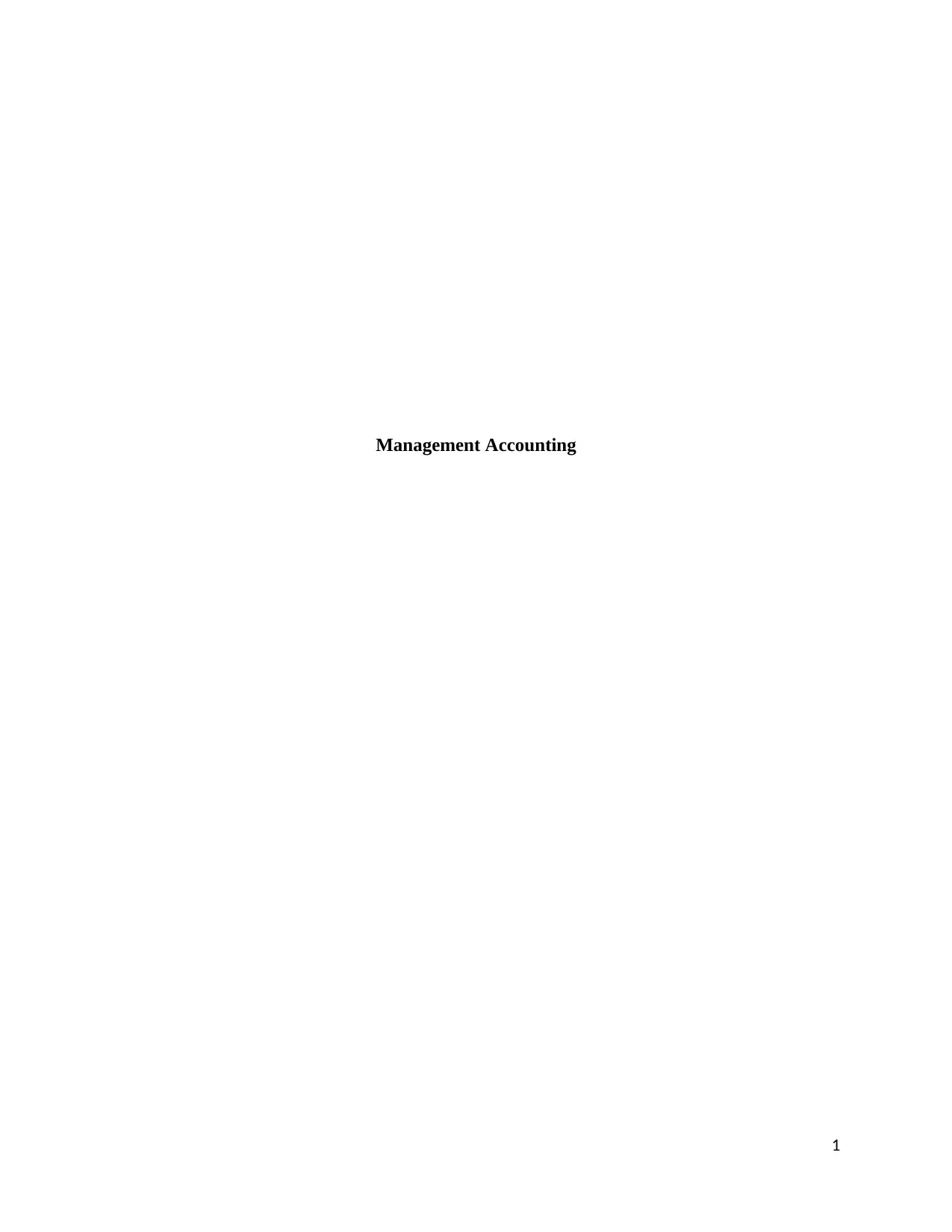
Management Accounting
1
1
Paraphrase This Document
Need a fresh take? Get an instant paraphrase of this document with our AI Paraphraser
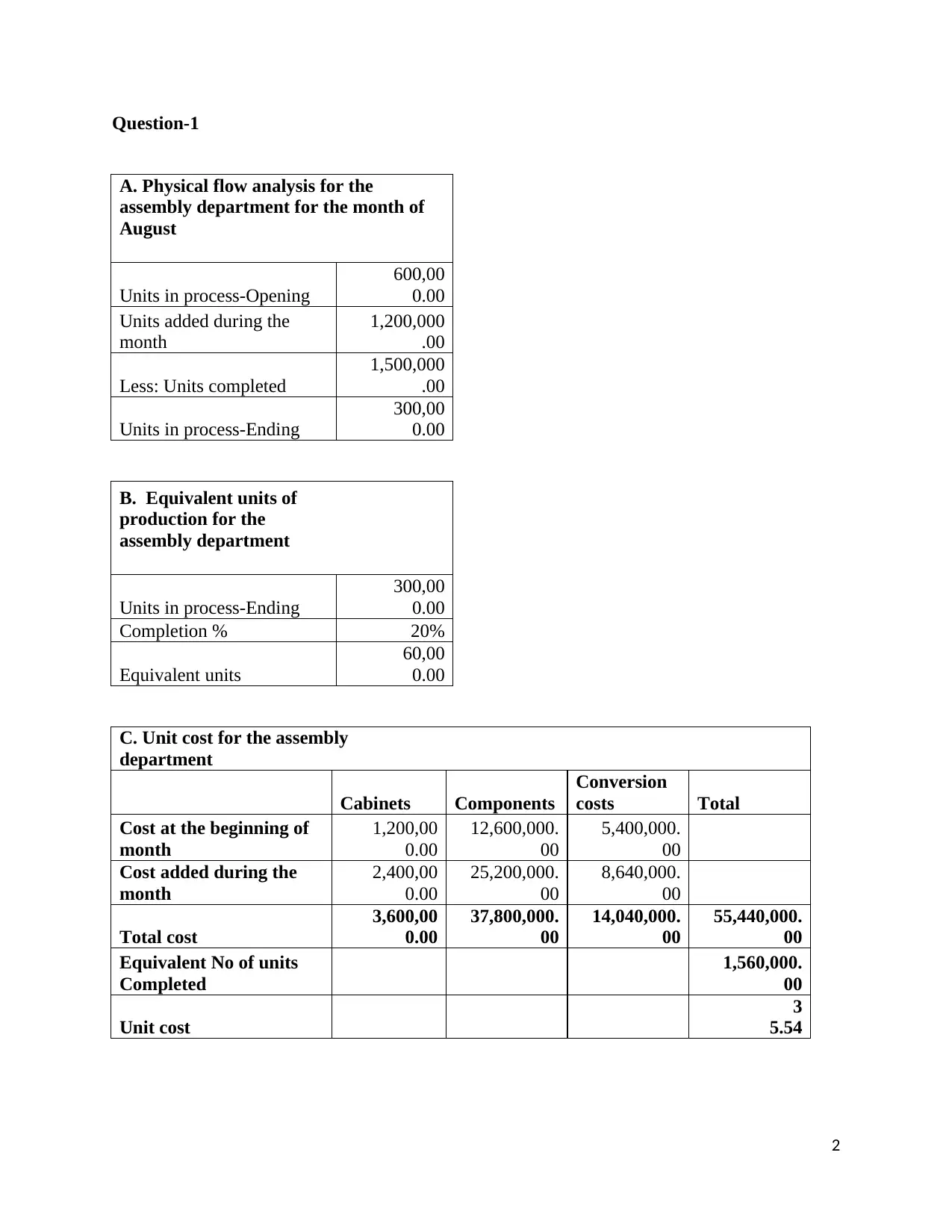
Question-1
A. Physical flow analysis for the
assembly department for the month of
August
Units in process-Opening
600,00
0.00
Units added during the
month
1,200,000
.00
Less: Units completed
1,500,000
.00
Units in process-Ending
300,00
0.00
B. Equivalent units of
production for the
assembly department
Units in process-Ending
300,00
0.00
Completion % 20%
Equivalent units
60,00
0.00
C. Unit cost for the assembly
department
Cabinets Components
Conversion
costs Total
Cost at the beginning of
month
1,200,00
0.00
12,600,000.
00
5,400,000.
00
Cost added during the
month
2,400,00
0.00
25,200,000.
00
8,640,000.
00
Total cost
3,600,00
0.00
37,800,000.
00
14,040,000.
00
55,440,000.
00
Equivalent No of units
Completed
1,560,000.
00
Unit cost
3
5.54
2
A. Physical flow analysis for the
assembly department for the month of
August
Units in process-Opening
600,00
0.00
Units added during the
month
1,200,000
.00
Less: Units completed
1,500,000
.00
Units in process-Ending
300,00
0.00
B. Equivalent units of
production for the
assembly department
Units in process-Ending
300,00
0.00
Completion % 20%
Equivalent units
60,00
0.00
C. Unit cost for the assembly
department
Cabinets Components
Conversion
costs Total
Cost at the beginning of
month
1,200,00
0.00
12,600,000.
00
5,400,000.
00
Cost added during the
month
2,400,00
0.00
25,200,000.
00
8,640,000.
00
Total cost
3,600,00
0.00
37,800,000.
00
14,040,000.
00
55,440,000.
00
Equivalent No of units
Completed
1,560,000.
00
Unit cost
3
5.54
2
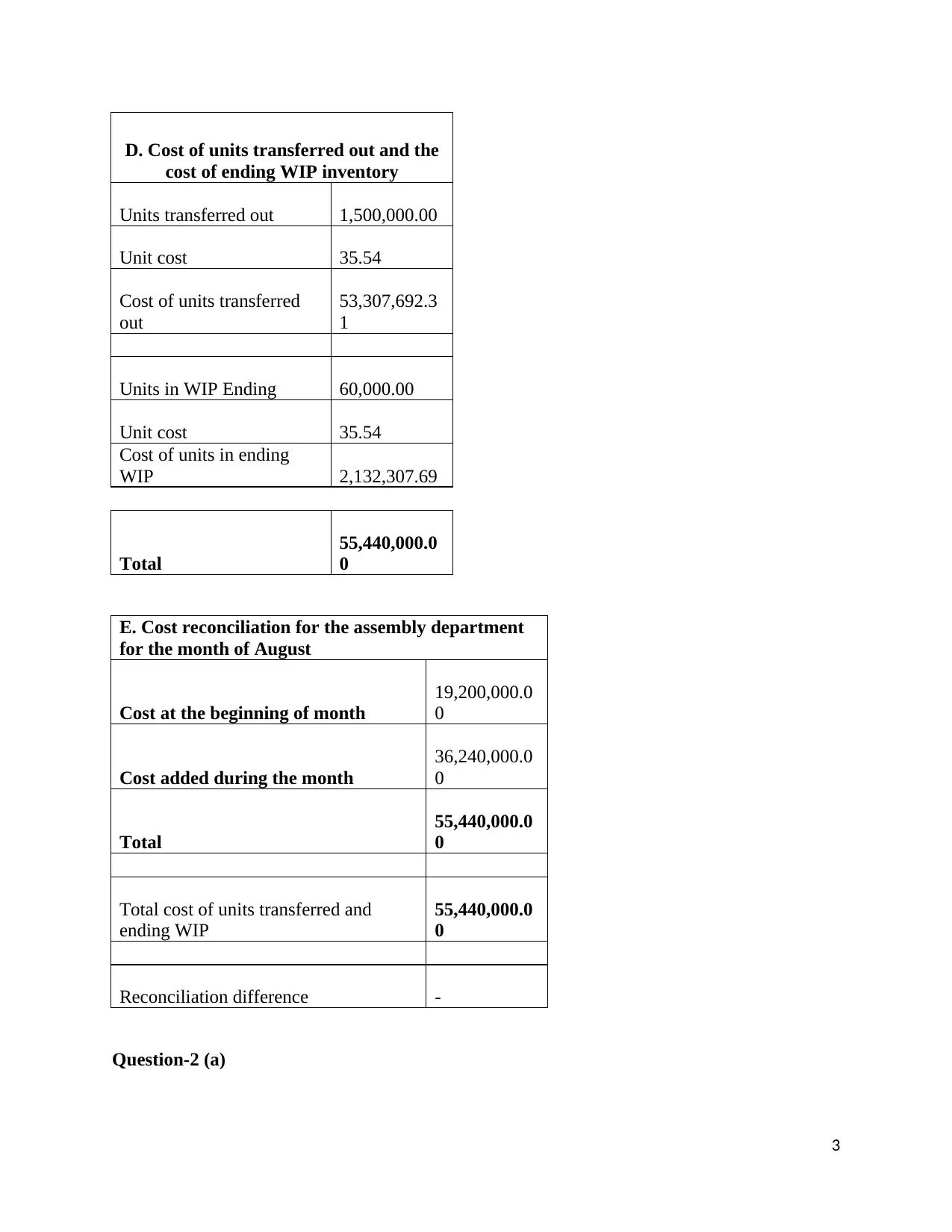
D. Cost of units transferred out and the
cost of ending WIP inventory
Units transferred out 1,500,000.00
Unit cost 35.54
Cost of units transferred
out
53,307,692.3
1
Units in WIP Ending 60,000.00
Unit cost 35.54
Cost of units in ending
WIP 2,132,307.69
Total
55,440,000.0
0
E. Cost reconciliation for the assembly department
for the month of August
Cost at the beginning of month
19,200,000.0
0
Cost added during the month
36,240,000.0
0
Total
55,440,000.0
0
Total cost of units transferred and
ending WIP
55,440,000.0
0
Reconciliation difference -
Question-2 (a)
3
cost of ending WIP inventory
Units transferred out 1,500,000.00
Unit cost 35.54
Cost of units transferred
out
53,307,692.3
1
Units in WIP Ending 60,000.00
Unit cost 35.54
Cost of units in ending
WIP 2,132,307.69
Total
55,440,000.0
0
E. Cost reconciliation for the assembly department
for the month of August
Cost at the beginning of month
19,200,000.0
0
Cost added during the month
36,240,000.0
0
Total
55,440,000.0
0
Total cost of units transferred and
ending WIP
55,440,000.0
0
Reconciliation difference -
Question-2 (a)
3
⊘ This is a preview!⊘
Do you want full access?
Subscribe today to unlock all pages.

Trusted by 1+ million students worldwide
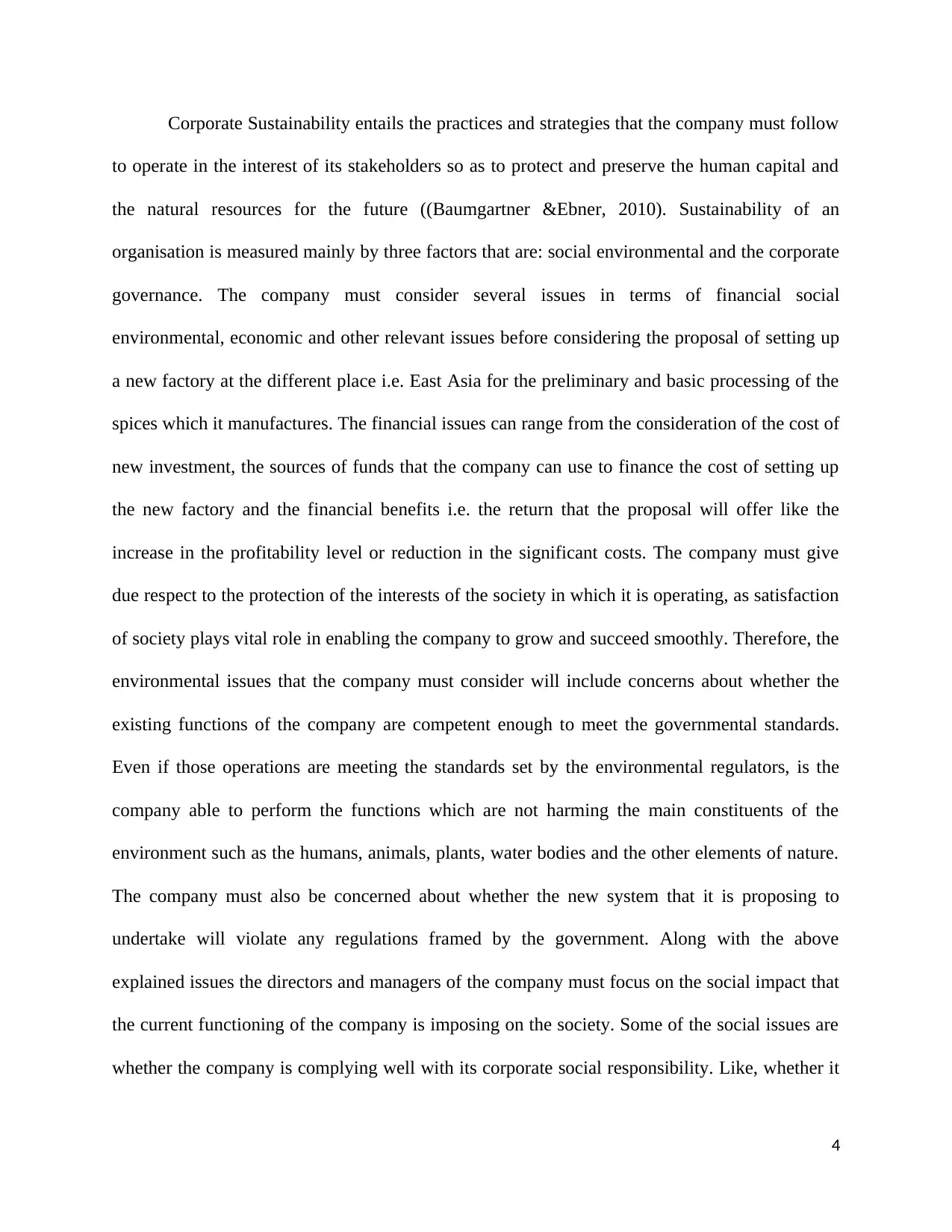
Corporate Sustainability entails the practices and strategies that the company must follow
to operate in the interest of its stakeholders so as to protect and preserve the human capital and
the natural resources for the future ((Baumgartner &Ebner, 2010). Sustainability of an
organisation is measured mainly by three factors that are: social environmental and the corporate
governance. The company must consider several issues in terms of financial social
environmental, economic and other relevant issues before considering the proposal of setting up
a new factory at the different place i.e. East Asia for the preliminary and basic processing of the
spices which it manufactures. The financial issues can range from the consideration of the cost of
new investment, the sources of funds that the company can use to finance the cost of setting up
the new factory and the financial benefits i.e. the return that the proposal will offer like the
increase in the profitability level or reduction in the significant costs. The company must give
due respect to the protection of the interests of the society in which it is operating, as satisfaction
of society plays vital role in enabling the company to grow and succeed smoothly. Therefore, the
environmental issues that the company must consider will include concerns about whether the
existing functions of the company are competent enough to meet the governmental standards.
Even if those operations are meeting the standards set by the environmental regulators, is the
company able to perform the functions which are not harming the main constituents of the
environment such as the humans, animals, plants, water bodies and the other elements of nature.
The company must also be concerned about whether the new system that it is proposing to
undertake will violate any regulations framed by the government. Along with the above
explained issues the directors and managers of the company must focus on the social impact that
the current functioning of the company is imposing on the society. Some of the social issues are
whether the company is complying well with its corporate social responsibility. Like, whether it
4
to operate in the interest of its stakeholders so as to protect and preserve the human capital and
the natural resources for the future ((Baumgartner &Ebner, 2010). Sustainability of an
organisation is measured mainly by three factors that are: social environmental and the corporate
governance. The company must consider several issues in terms of financial social
environmental, economic and other relevant issues before considering the proposal of setting up
a new factory at the different place i.e. East Asia for the preliminary and basic processing of the
spices which it manufactures. The financial issues can range from the consideration of the cost of
new investment, the sources of funds that the company can use to finance the cost of setting up
the new factory and the financial benefits i.e. the return that the proposal will offer like the
increase in the profitability level or reduction in the significant costs. The company must give
due respect to the protection of the interests of the society in which it is operating, as satisfaction
of society plays vital role in enabling the company to grow and succeed smoothly. Therefore, the
environmental issues that the company must consider will include concerns about whether the
existing functions of the company are competent enough to meet the governmental standards.
Even if those operations are meeting the standards set by the environmental regulators, is the
company able to perform the functions which are not harming the main constituents of the
environment such as the humans, animals, plants, water bodies and the other elements of nature.
The company must also be concerned about whether the new system that it is proposing to
undertake will violate any regulations framed by the government. Along with the above
explained issues the directors and managers of the company must focus on the social impact that
the current functioning of the company is imposing on the society. Some of the social issues are
whether the company is complying well with its corporate social responsibility. Like, whether it
4
Paraphrase This Document
Need a fresh take? Get an instant paraphrase of this document with our AI Paraphraser
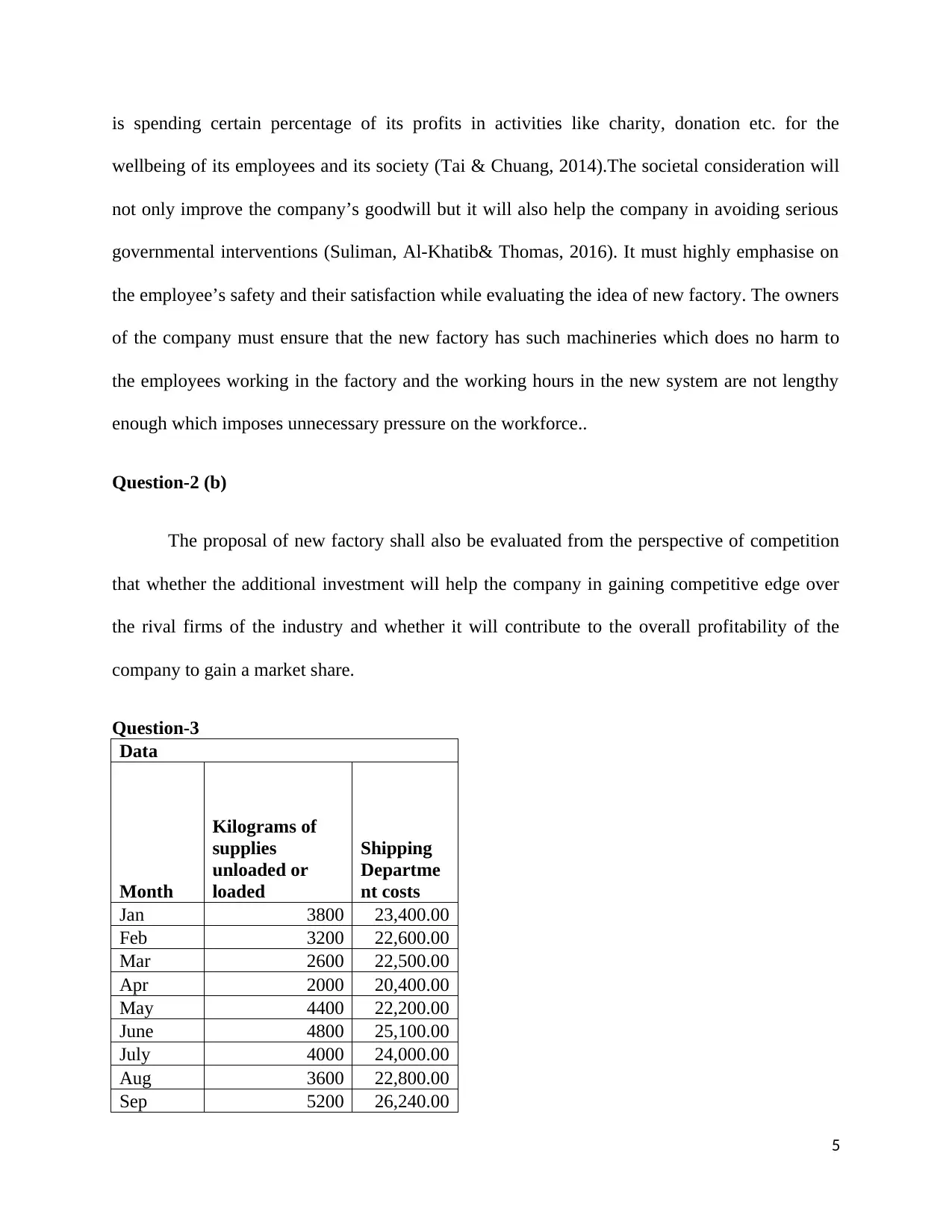
is spending certain percentage of its profits in activities like charity, donation etc. for the
wellbeing of its employees and its society (Tai & Chuang, 2014).The societal consideration will
not only improve the company’s goodwill but it will also help the company in avoiding serious
governmental interventions (Suliman, Al-Khatib& Thomas, 2016). It must highly emphasise on
the employee’s safety and their satisfaction while evaluating the idea of new factory. The owners
of the company must ensure that the new factory has such machineries which does no harm to
the employees working in the factory and the working hours in the new system are not lengthy
enough which imposes unnecessary pressure on the workforce..
Question-2 (b)
The proposal of new factory shall also be evaluated from the perspective of competition
that whether the additional investment will help the company in gaining competitive edge over
the rival firms of the industry and whether it will contribute to the overall profitability of the
company to gain a market share.
Question-3
Data
Month
Kilograms of
supplies
unloaded or
loaded
Shipping
Departme
nt costs
Jan 3800 23,400.00
Feb 3200 22,600.00
Mar 2600 22,500.00
Apr 2000 20,400.00
May 4400 22,200.00
June 4800 25,100.00
July 4000 24,000.00
Aug 3600 22,800.00
Sep 5200 26,240.00
5
wellbeing of its employees and its society (Tai & Chuang, 2014).The societal consideration will
not only improve the company’s goodwill but it will also help the company in avoiding serious
governmental interventions (Suliman, Al-Khatib& Thomas, 2016). It must highly emphasise on
the employee’s safety and their satisfaction while evaluating the idea of new factory. The owners
of the company must ensure that the new factory has such machineries which does no harm to
the employees working in the factory and the working hours in the new system are not lengthy
enough which imposes unnecessary pressure on the workforce..
Question-2 (b)
The proposal of new factory shall also be evaluated from the perspective of competition
that whether the additional investment will help the company in gaining competitive edge over
the rival firms of the industry and whether it will contribute to the overall profitability of the
company to gain a market share.
Question-3
Data
Month
Kilograms of
supplies
unloaded or
loaded
Shipping
Departme
nt costs
Jan 3800 23,400.00
Feb 3200 22,600.00
Mar 2600 22,500.00
Apr 2000 20,400.00
May 4400 22,200.00
June 4800 25,100.00
July 4000 24,000.00
Aug 3600 22,800.00
Sep 5200 26,240.00
5
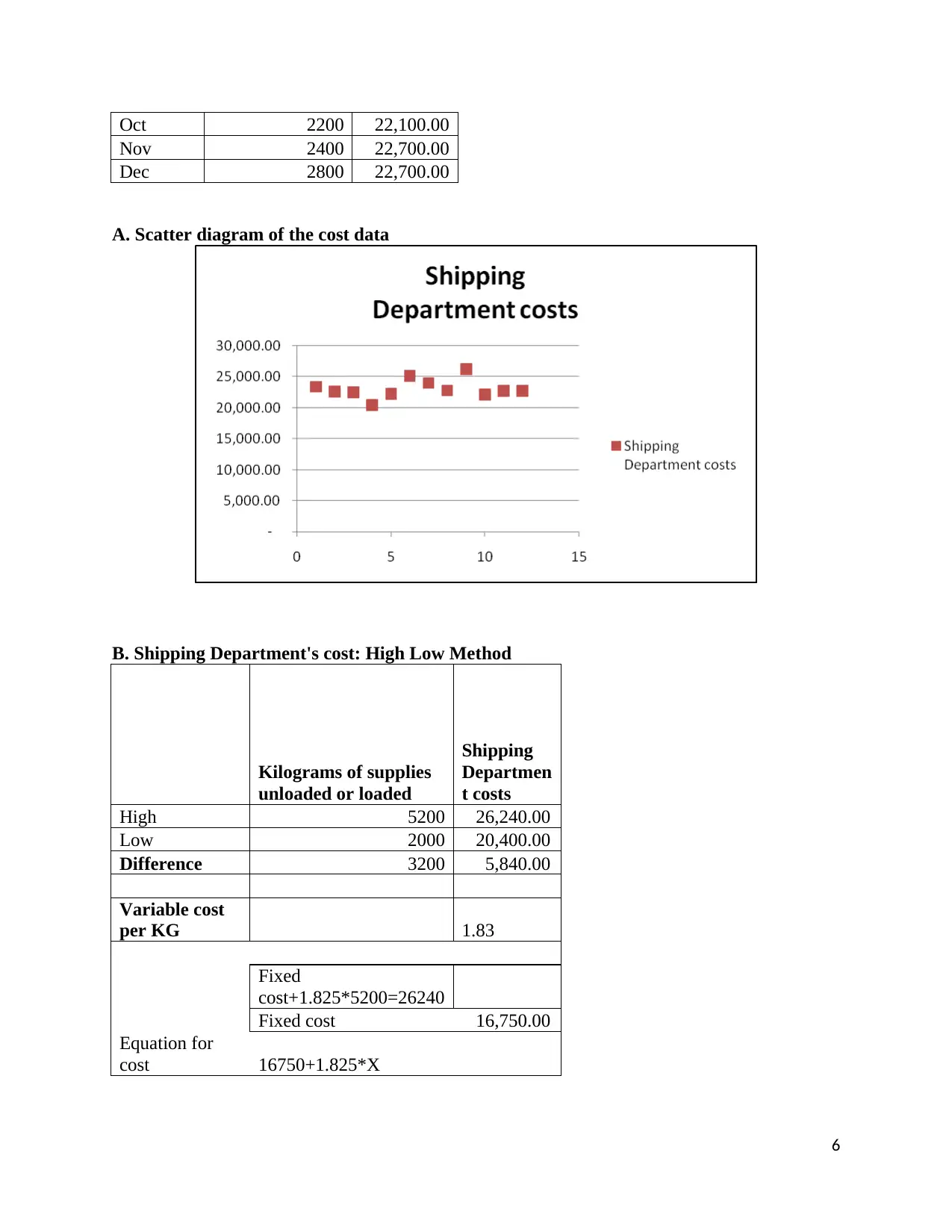
Oct 2200 22,100.00
Nov 2400 22,700.00
Dec 2800 22,700.00
A. Scatter diagram of the cost data
B. Shipping Department's cost: High Low Method
Kilograms of supplies
unloaded or loaded
Shipping
Departmen
t costs
High 5200 26,240.00
Low 2000 20,400.00
Difference 3200 5,840.00
Variable cost
per KG 1.83
Fixed
cost+1.825*5200=26240
Fixed cost 16,750.00
Equation for
cost 16750+1.825*X
6
Nov 2400 22,700.00
Dec 2800 22,700.00
A. Scatter diagram of the cost data
B. Shipping Department's cost: High Low Method
Kilograms of supplies
unloaded or loaded
Shipping
Departmen
t costs
High 5200 26,240.00
Low 2000 20,400.00
Difference 3200 5,840.00
Variable cost
per KG 1.83
Fixed
cost+1.825*5200=26240
Fixed cost 16,750.00
Equation for
cost 16750+1.825*X
6
⊘ This is a preview!⊘
Do you want full access?
Subscribe today to unlock all pages.

Trusted by 1+ million students worldwide
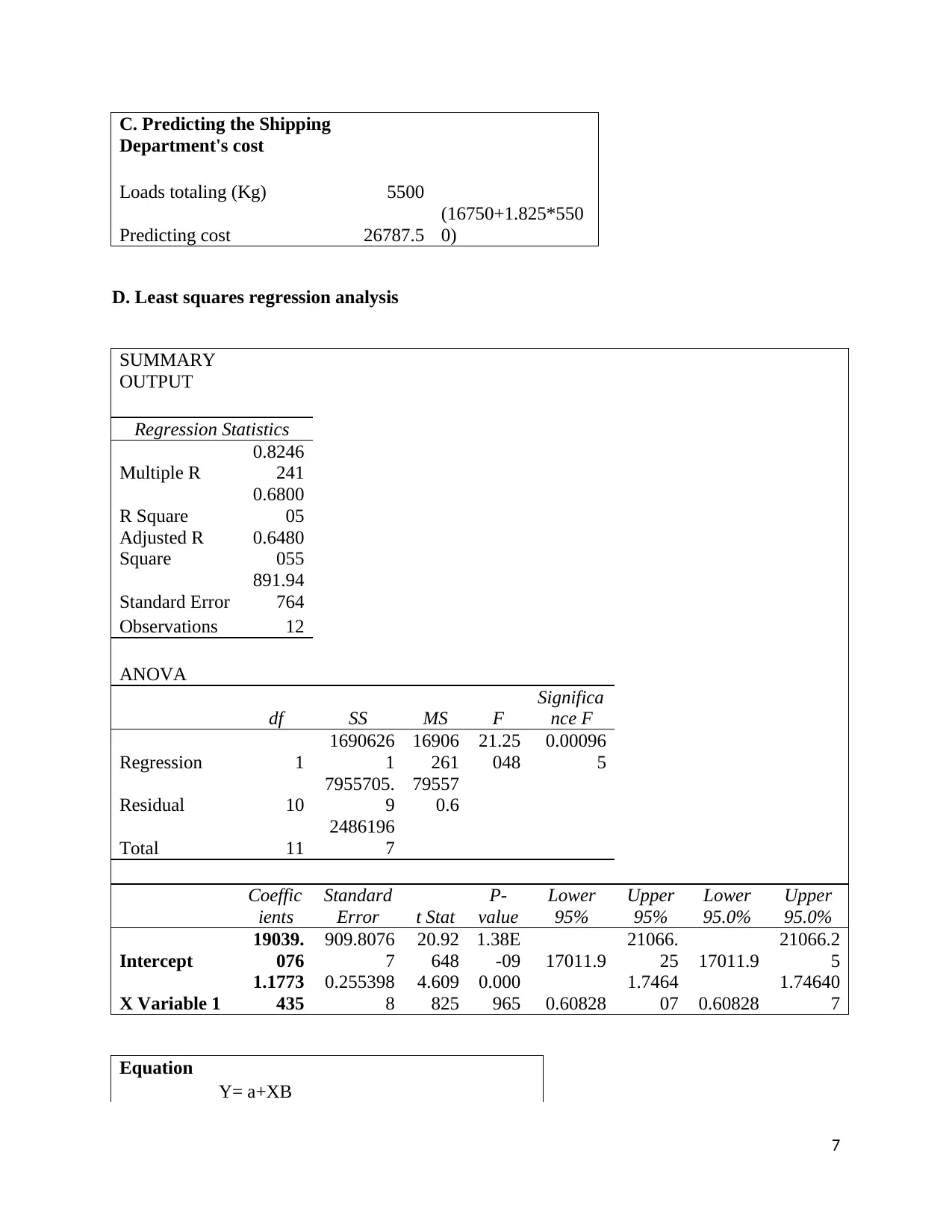
C. Predicting the Shipping
Department's cost
Loads totaling (Kg) 5500
Predicting cost 26787.5
(16750+1.825*550
0)
D. Least squares regression analysis
SUMMARY
OUTPUT
Regression Statistics
Multiple R
0.8246
241
R Square
0.6800
05
Adjusted R
Square
0.6480
055
Standard Error
891.94
764
Observations 12
ANOVA
df SS MS F
Significa
nce F
Regression 1
1690626
1
16906
261
21.25
048
0.00096
5
Residual 10
7955705.
9
79557
0.6
Total 11
2486196
7
Coeffic
ients
Standard
Error t Stat
P-
value
Lower
95%
Upper
95%
Lower
95.0%
Upper
95.0%
Intercept
19039.
076
909.8076
7
20.92
648
1.38E
-09 17011.9
21066.
25 17011.9
21066.2
5
X Variable 1
1.1773
435
0.255398
8
4.609
825
0.000
965 0.60828
1.7464
07 0.60828
1.74640
7
Equation
Y= a+XB
7
Department's cost
Loads totaling (Kg) 5500
Predicting cost 26787.5
(16750+1.825*550
0)
D. Least squares regression analysis
SUMMARY
OUTPUT
Regression Statistics
Multiple R
0.8246
241
R Square
0.6800
05
Adjusted R
Square
0.6480
055
Standard Error
891.94
764
Observations 12
ANOVA
df SS MS F
Significa
nce F
Regression 1
1690626
1
16906
261
21.25
048
0.00096
5
Residual 10
7955705.
9
79557
0.6
Total 11
2486196
7
Coeffic
ients
Standard
Error t Stat
P-
value
Lower
95%
Upper
95%
Lower
95.0%
Upper
95.0%
Intercept
19039.
076
909.8076
7
20.92
648
1.38E
-09 17011.9
21066.
25 17011.9
21066.2
5
X Variable 1
1.1773
435
0.255398
8
4.609
825
0.000
965 0.60828
1.7464
07 0.60828
1.74640
7
Equation
Y= a+XB
7
Paraphrase This Document
Need a fresh take? Get an instant paraphrase of this document with our AI Paraphraser
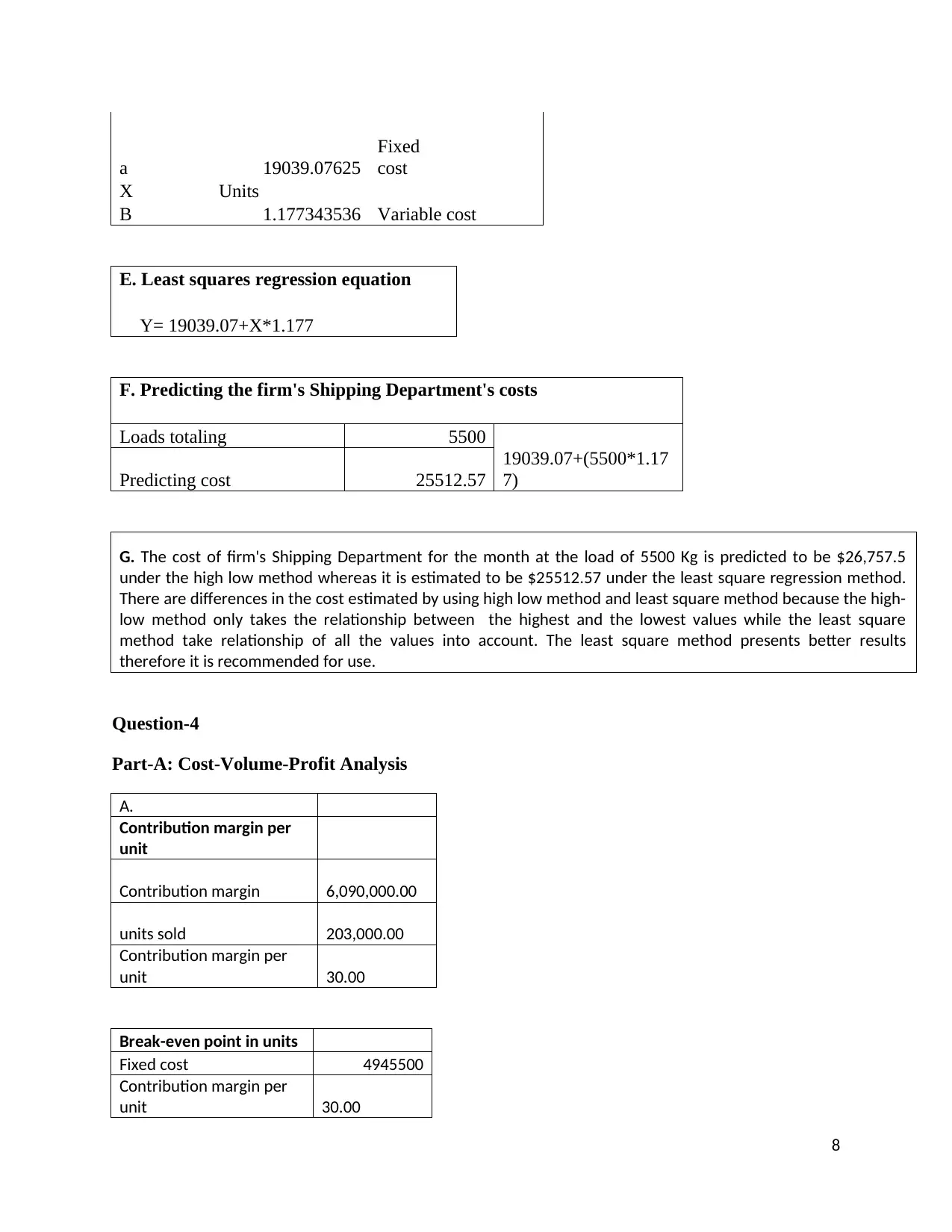
a 19039.07625
Fixed
cost
X Units
B 1.177343536 Variable cost
E. Least squares regression equation
Y= 19039.07+X*1.177
F. Predicting the firm's Shipping Department's costs
Loads totaling 5500
Predicting cost 25512.57
19039.07+(5500*1.17
7)
G. The cost of firm's Shipping Department for the month at the load of 5500 Kg is predicted to be $26,757.5
under the high low method whereas it is estimated to be $25512.57 under the least square regression method.
There are differences in the cost estimated by using high low method and least square method because the high-
low method only takes the relationship between the highest and the lowest values while the least square
method take relationship of all the values into account. The least square method presents better results
therefore it is recommended for use.
Question-4
Part-A: Cost-Volume-Profit Analysis
A.
Contribution margin per
unit
Contribution margin 6,090,000.00
units sold 203,000.00
Contribution margin per
unit 30.00
Break-even point in units
Fixed cost 4945500
Contribution margin per
unit 30.00
8
Fixed
cost
X Units
B 1.177343536 Variable cost
E. Least squares regression equation
Y= 19039.07+X*1.177
F. Predicting the firm's Shipping Department's costs
Loads totaling 5500
Predicting cost 25512.57
19039.07+(5500*1.17
7)
G. The cost of firm's Shipping Department for the month at the load of 5500 Kg is predicted to be $26,757.5
under the high low method whereas it is estimated to be $25512.57 under the least square regression method.
There are differences in the cost estimated by using high low method and least square method because the high-
low method only takes the relationship between the highest and the lowest values while the least square
method take relationship of all the values into account. The least square method presents better results
therefore it is recommended for use.
Question-4
Part-A: Cost-Volume-Profit Analysis
A.
Contribution margin per
unit
Contribution margin 6,090,000.00
units sold 203,000.00
Contribution margin per
unit 30.00
Break-even point in units
Fixed cost 4945500
Contribution margin per
unit 30.00
8
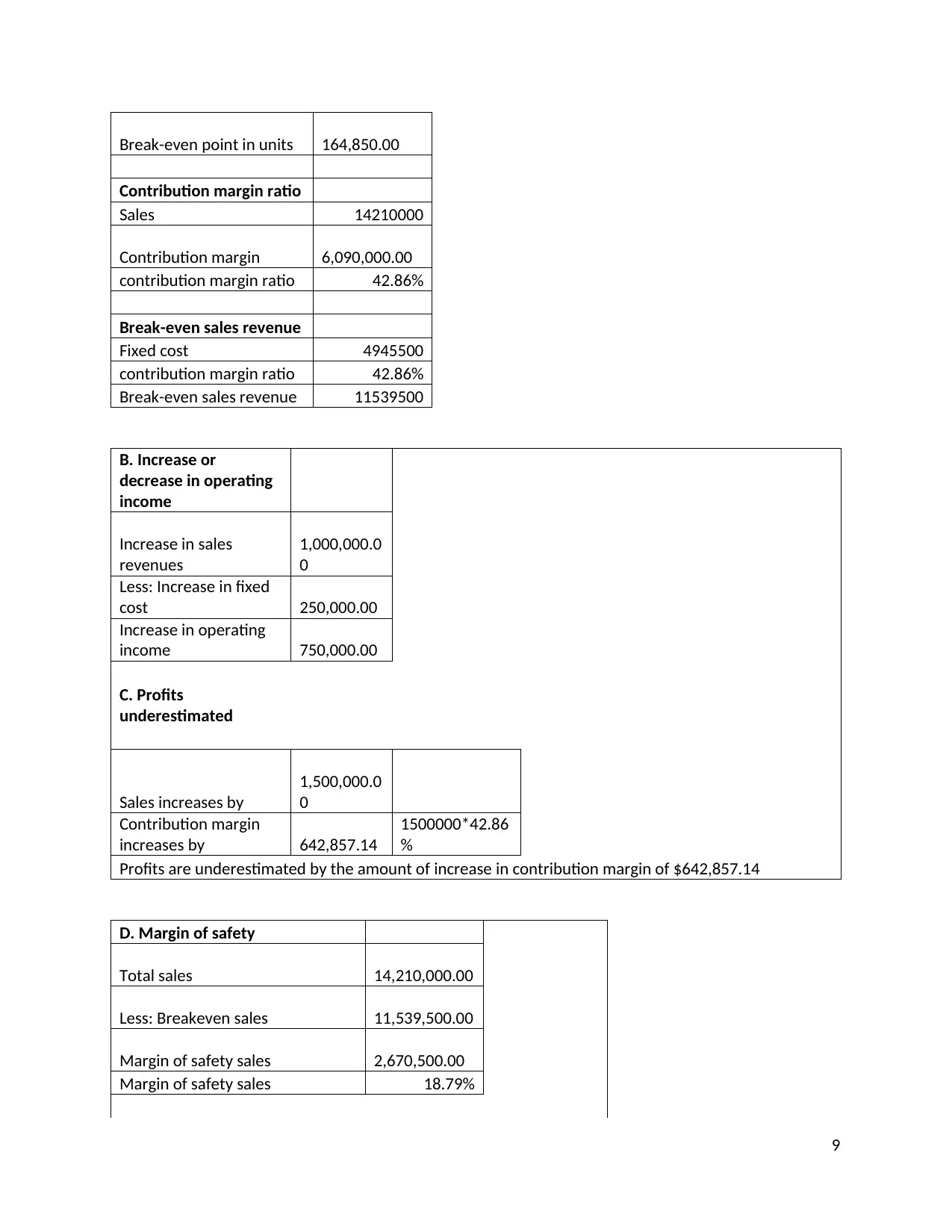
Break-even point in units 164,850.00
Contribution margin ratio
Sales 14210000
Contribution margin 6,090,000.00
contribution margin ratio 42.86%
Break-even sales revenue
Fixed cost 4945500
contribution margin ratio 42.86%
Break-even sales revenue 11539500
B. Increase or
decrease in operating
income
Increase in sales
revenues
1,000,000.0
0
Less: Increase in fixed
cost 250,000.00
Increase in operating
income 750,000.00
C. Profits
underestimated
Sales increases by
1,500,000.0
0
Contribution margin
increases by 642,857.14
1500000*42.86
%
Profits are underestimated by the amount of increase in contribution margin of $642,857.14
D. Margin of safety
Total sales 14,210,000.00
Less: Breakeven sales 11,539,500.00
Margin of safety sales 2,670,500.00
Margin of safety sales 18.79%
9
Contribution margin ratio
Sales 14210000
Contribution margin 6,090,000.00
contribution margin ratio 42.86%
Break-even sales revenue
Fixed cost 4945500
contribution margin ratio 42.86%
Break-even sales revenue 11539500
B. Increase or
decrease in operating
income
Increase in sales
revenues
1,000,000.0
0
Less: Increase in fixed
cost 250,000.00
Increase in operating
income 750,000.00
C. Profits
underestimated
Sales increases by
1,500,000.0
0
Contribution margin
increases by 642,857.14
1500000*42.86
%
Profits are underestimated by the amount of increase in contribution margin of $642,857.14
D. Margin of safety
Total sales 14,210,000.00
Less: Breakeven sales 11,539,500.00
Margin of safety sales 2,670,500.00
Margin of safety sales 18.79%
9
⊘ This is a preview!⊘
Do you want full access?
Subscribe today to unlock all pages.

Trusted by 1+ million students worldwide
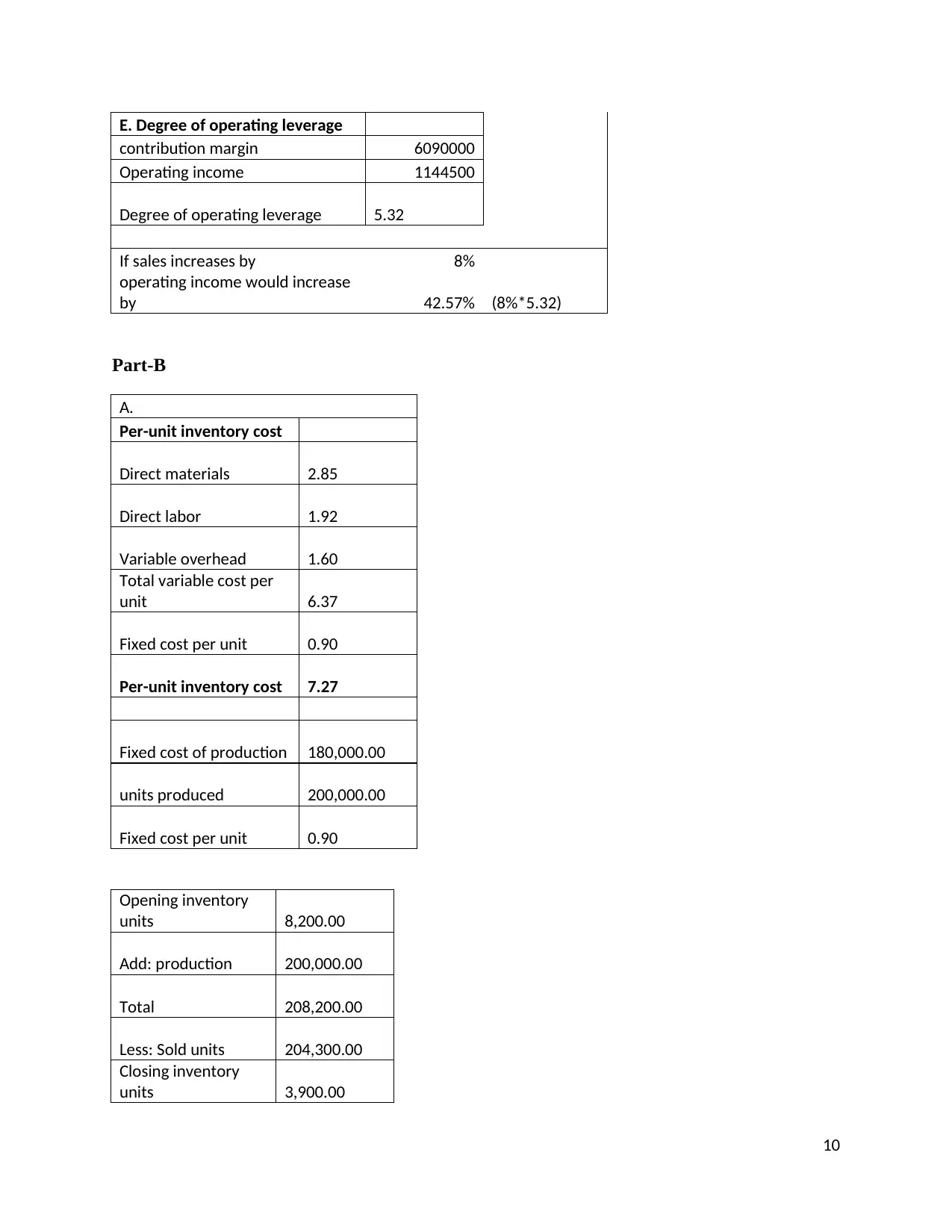
E. Degree of operating leverage
contribution margin 6090000
Operating income 1144500
Degree of operating leverage 5.32
If sales increases by 8%
operating income would increase
by 42.57% (8%*5.32)
Part-B
A.
Per-unit inventory cost
Direct materials 2.85
Direct labor 1.92
Variable overhead 1.60
Total variable cost per
unit 6.37
Fixed cost per unit 0.90
Per-unit inventory cost 7.27
Fixed cost of production 180,000.00
units produced 200,000.00
Fixed cost per unit 0.90
Opening inventory
units 8,200.00
Add: production 200,000.00
Total 208,200.00
Less: Sold units 204,300.00
Closing inventory
units 3,900.00
10
contribution margin 6090000
Operating income 1144500
Degree of operating leverage 5.32
If sales increases by 8%
operating income would increase
by 42.57% (8%*5.32)
Part-B
A.
Per-unit inventory cost
Direct materials 2.85
Direct labor 1.92
Variable overhead 1.60
Total variable cost per
unit 6.37
Fixed cost per unit 0.90
Per-unit inventory cost 7.27
Fixed cost of production 180,000.00
units produced 200,000.00
Fixed cost per unit 0.90
Opening inventory
units 8,200.00
Add: production 200,000.00
Total 208,200.00
Less: Sold units 204,300.00
Closing inventory
units 3,900.00
10
Paraphrase This Document
Need a fresh take? Get an instant paraphrase of this document with our AI Paraphraser
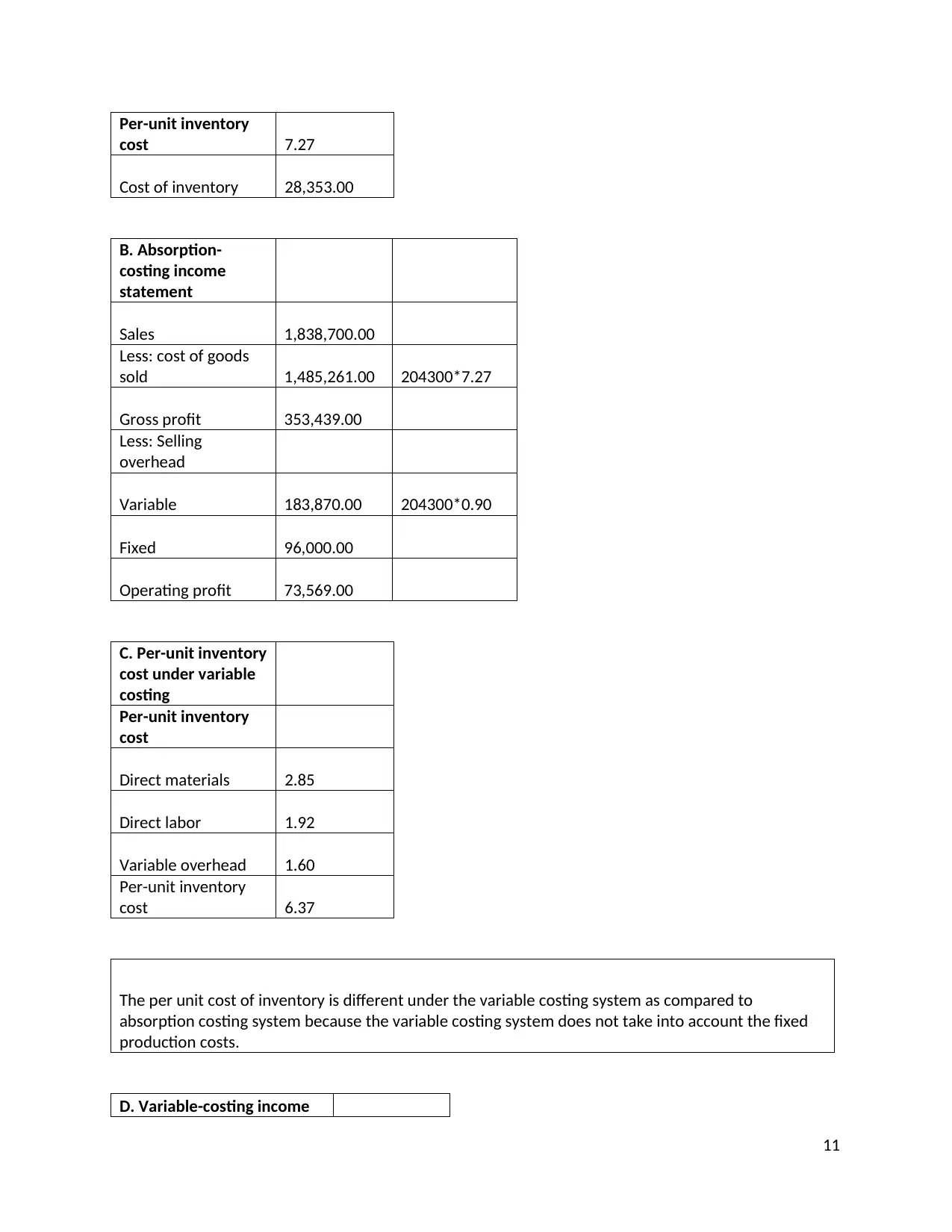
Per-unit inventory
cost 7.27
Cost of inventory 28,353.00
B. Absorption-
costing income
statement
Sales 1,838,700.00
Less: cost of goods
sold 1,485,261.00 204300*7.27
Gross profit 353,439.00
Less: Selling
overhead
Variable 183,870.00 204300*0.90
Fixed 96,000.00
Operating profit 73,569.00
C. Per-unit inventory
cost under variable
costing
Per-unit inventory
cost
Direct materials 2.85
Direct labor 1.92
Variable overhead 1.60
Per-unit inventory
cost 6.37
The per unit cost of inventory is different under the variable costing system as compared to
absorption costing system because the variable costing system does not take into account the fixed
production costs.
D. Variable-costing income
11
cost 7.27
Cost of inventory 28,353.00
B. Absorption-
costing income
statement
Sales 1,838,700.00
Less: cost of goods
sold 1,485,261.00 204300*7.27
Gross profit 353,439.00
Less: Selling
overhead
Variable 183,870.00 204300*0.90
Fixed 96,000.00
Operating profit 73,569.00
C. Per-unit inventory
cost under variable
costing
Per-unit inventory
cost
Direct materials 2.85
Direct labor 1.92
Variable overhead 1.60
Per-unit inventory
cost 6.37
The per unit cost of inventory is different under the variable costing system as compared to
absorption costing system because the variable costing system does not take into account the fixed
production costs.
D. Variable-costing income
11
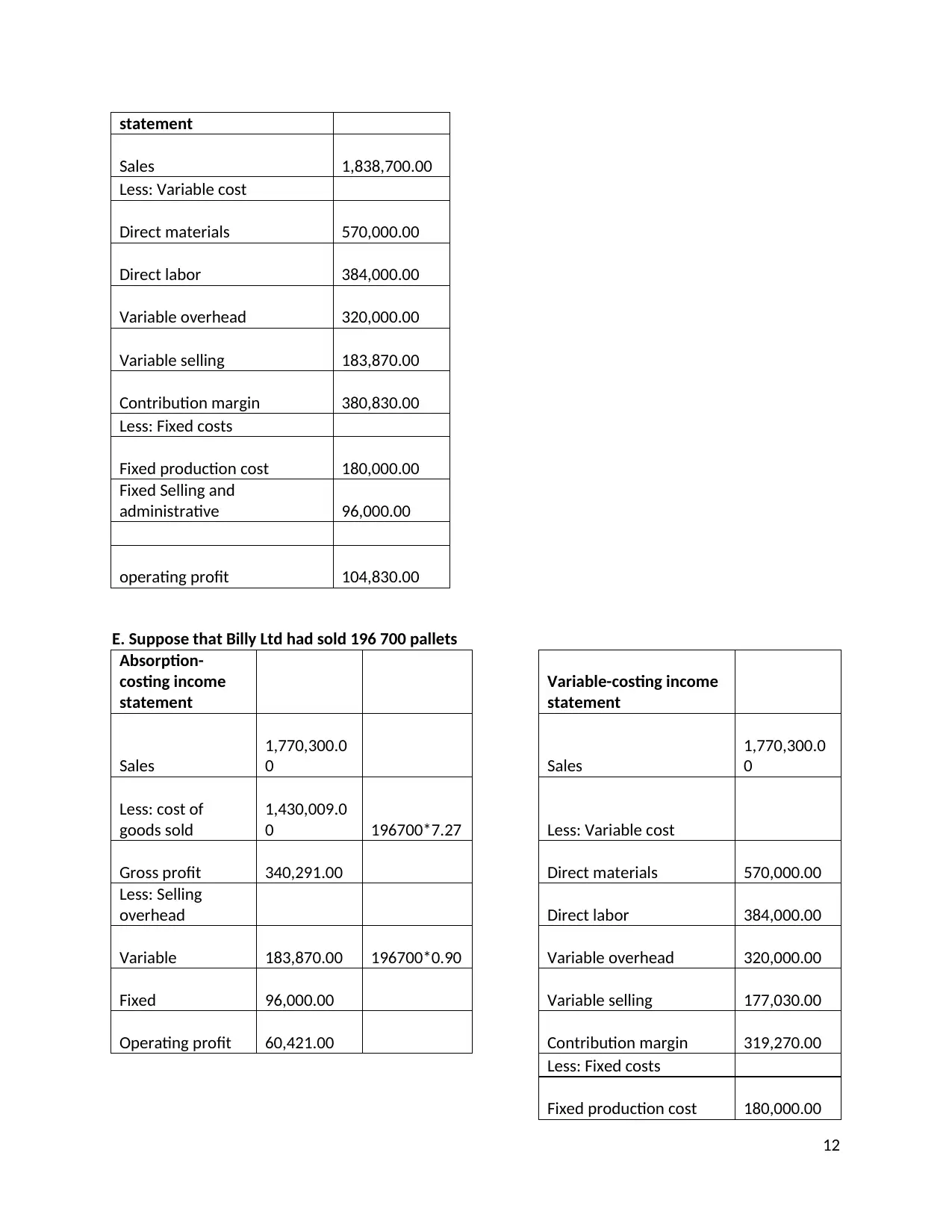
statement
Sales 1,838,700.00
Less: Variable cost
Direct materials 570,000.00
Direct labor 384,000.00
Variable overhead 320,000.00
Variable selling 183,870.00
Contribution margin 380,830.00
Less: Fixed costs
Fixed production cost 180,000.00
Fixed Selling and
administrative 96,000.00
operating profit 104,830.00
E. Suppose that Billy Ltd had sold 196 700 pallets
Absorption-
costing income
statement
Variable-costing income
statement
Sales
1,770,300.0
0 Sales
1,770,300.0
0
Less: cost of
goods sold
1,430,009.0
0 196700*7.27 Less: Variable cost
Gross profit 340,291.00 Direct materials 570,000.00
Less: Selling
overhead Direct labor 384,000.00
Variable 183,870.00 196700*0.90 Variable overhead 320,000.00
Fixed 96,000.00 Variable selling 177,030.00
Operating profit 60,421.00 Contribution margin 319,270.00
Less: Fixed costs
Fixed production cost 180,000.00
12
Sales 1,838,700.00
Less: Variable cost
Direct materials 570,000.00
Direct labor 384,000.00
Variable overhead 320,000.00
Variable selling 183,870.00
Contribution margin 380,830.00
Less: Fixed costs
Fixed production cost 180,000.00
Fixed Selling and
administrative 96,000.00
operating profit 104,830.00
E. Suppose that Billy Ltd had sold 196 700 pallets
Absorption-
costing income
statement
Variable-costing income
statement
Sales
1,770,300.0
0 Sales
1,770,300.0
0
Less: cost of
goods sold
1,430,009.0
0 196700*7.27 Less: Variable cost
Gross profit 340,291.00 Direct materials 570,000.00
Less: Selling
overhead Direct labor 384,000.00
Variable 183,870.00 196700*0.90 Variable overhead 320,000.00
Fixed 96,000.00 Variable selling 177,030.00
Operating profit 60,421.00 Contribution margin 319,270.00
Less: Fixed costs
Fixed production cost 180,000.00
12
⊘ This is a preview!⊘
Do you want full access?
Subscribe today to unlock all pages.

Trusted by 1+ million students worldwide
1 out of 16
Your All-in-One AI-Powered Toolkit for Academic Success.
+13062052269
info@desklib.com
Available 24*7 on WhatsApp / Email
![[object Object]](/_next/static/media/star-bottom.7253800d.svg)
Unlock your academic potential
Copyright © 2020–2025 A2Z Services. All Rights Reserved. Developed and managed by ZUCOL.


